December 20th, 2018 by iisg_superadmin
Deadline: January 29, 2019
The Illinois-Indiana Sea Grant College Program will be reviewed Feb. 5-7, 2019, by a team convened by the National Sea Grant College Program. The review will be conducted at the Illini Center in Chicago, Illinois, and will consider all aspects of Illinois-Indiana Sea Grant’s programs, including management and organization, performance, research, stakeholder engagement and collaborative activities, including those with various offices of the National Oceanic and Atmospheric Administration.
This notice invites you to participate in our review by emailing your comments about Illinois-Indiana Sea Grant to oar.sg-feedback@noaa.gov.
Kindly send your comments at your earliest convenience and note that the comment period will end on Jan. 29, 2019, one week before the site review visit.
Please include “Illinois-Indiana Sea Grant site review” in the subject line.
Thank you for assisting us by letting the review team hear from you.
Sincerely,
Tomas Höök
Director, Illinois-Indiana Sea Grant
Illinois-Indiana Sea Grant is a part of University of Illinois Extension and Purdue Extension.
November 20th, 2018 by iisg_superadmin
For over 35 years, Illinois-Indiana Sea Grant (IISG) has been working to foster a healthy environment and economy in the southern Lake Michigan region. We have a long record of leading research, outreach, and education in areas such as aquatic invasive species and pollution prevention. We have developed decision tools for communities and their residents, helped communities adopt green infrastructure to reduce stormwater runoff, and have helped bring the Great Lakes to students.
We did this work with the support and collaboration of our partners. IISG is administratively housed in and shares positions with University of Illinois Extension, Purdue Extension, and the Purdue University Department of Forestry and Natural Resources. We share positions with the University of Illinois Prairie Research Institute, Midwest Regional Climate Center, Illinois Water Resources Center, and Purdue University Northwest.
The U.S. EPA Great Lakes National Program Office provides support, with assistance from the U.S. Geological Survey, for our specialists and educators who help bring EPA science to the public. The Chicago Metropolitan Agency for Planning, Chicago Botanic Garden, McHenry County Extension, and Loyola University Chicago provide office space and administrative support for our specialists as well. Our successes would not be possible without these and many other partners.
In recent years, our impacts include supporting quagga mussel research that led to a $1 million in new federal funding, informing water supply planning in the greater Chicago region, and supporting medicine collection programs as they reach a significant milestone.
We look forward to carrying on with our long-term projects addressing critical coastal issues. As IISG moves forward with new faces and ideas, we are poised to tackle emerging issues and opportunities in the region.
Tomas Höök
Director, Illinois-Indiana Sea Grant
Illinois-Indiana Sea Grant is a part of University of Illinois Extension and Purdue Extension.
October 30th, 2018 by iisg_superadmin
Lately, Sheboygan is on the upswing. This city in Wisconsin that sits along the Sheboygan River is booming with new housing, more tourism, and more water-based recreation opportunities, according to a recent Great Lakes Commission study. Illinois-Indiana Sea Grant (IISG), as part of a team of partners, provided expertise that contributed to this success story.
Not so long ago, the river was considered a black eye on the community. Labeled one of the most polluted rivers in the country, it was contaminated with an alphabet soup of PCBs and PAHs. With funding from the Great Lakes Restoration Initiative, approximately 300,000 cubic yards of contaminated sediment (or 15,000 full dump trucks) were removed from the river in 2012-2013. As a result, river-goers enjoy a deeper river with better navigation and access, and a cleaner habitat for fish and wildlife to thrive.
“There’s no question in my mind that if that cleanup effort hadn’t gone on, we would not see the kind of development and enthusiasm going on in our community,” said Adam Payne, Sheboygan County administrator. “It absolutely triggered a lot of the good things that are in play.”
As is typical for projects funded through the Great Lakes Legacy Act, partners were key to its success, including federal, state, local—agencies, non-for-profits, private companies—the list is extensive. “The level of collaboration and teamwork was unprecedented of anything I had seen in my career,” added Payne.
For its part, IISG funded research to assess the economic impact of the contaminated river on housing prices. “We looked at actual sales of single family houses in the area from 2002-2004,” explained John Braden, University of Illinois economist (now retired). “And we surveyed 850 residents to understand people’s perceptions of the river, and their willingness to pay more for housing if the river was cleaned up.”
Braden found that property values for homes within five miles of the contaminated waterways were significantly depressed—an 8 percent discount, on average. This research and related Sea Grant outreach helped illustrate the value of the cleanup, helped to keep the Sheboygan community informed about the remediation process as it happened, and helped to change the conversation about sediment remediation.
“Sediment remediation is very expensive, so how can we justify these multi-million dollar projects?” said Caitie Nigrelli, IISG social scientist. “The main goal is to improve environmental quality of water resources, but if we understand more of the benefits, we can make a better case for these projects.”
Nigrelli worked with a Sheboygan outreach team in 2012 to provide information to stakeholders and the public. She helped convey the results of Braden’s research in her outreach efforts through publications and other venues. In addition, bringing her social science expertise to the project, she oversaw a study to bring community perceptions to light to better understand how to communicate about the sediment remediation project and its benefits to the public.
“We found that while the river was viewed as an asset, it had a negative stigma,” said Nigrelli. “Our interviews before the remediation revealed that residents saw the water as unclean and some were hesitant and even afraid to come in contact with the water.”
Due to years of sedimentation, the depth of Sheboygan River was also viewed as a major concern as its shallowness limited access for larger boats and sailboats. While the point of the remediation was to remove contaminants, a side benefit was an increase in river depth. These and other findings helped Nigrelli and the outreach team target public information to address specific concerns.
Payne describes the value of a well-informed public in terms of just getting through the remediation process. “To put it in perspective, when we were removing the contaminated soil from the river and harbor, we had trucks coming and going through the heart of the city every three to five minutes, 24/7. That’s disruptive, lots of dust, noise, traffic and that obviously raises folks eyebrows and raises concerns. I think where outreach efforts were so helpful is in raising awareness with the public—these potential benefits are why we are going to go through this.”
To learn more about remediation partnership possibilities, “A Seat at the Table: Great Lakes Legacy Act” is a new video that explains what it means to be a cost-share partner with the Environmental Protection Agency under GLLA. The video uses interviews with partners to describe the benefits and challenges of cost-share partnering, the cost-sharing mechanism, examples of in-kind services and the flexibility of partnerships.
To see what successful partnerships can accomplish, follow Nigrelli (@Gr8LakesLady) on Twitter as she has been sharing 22 sediment site success stories, including before and after photos, contamination causes, partnerships and cleanup details. Follow and join the conversation using #22SedimentStories.
October 16th, 2018 by iisg_superadmin
Through the Great Lakes Restoration Initiative, the Muskegon Lake Area of Concern took one step closer to a clean bill of health. At the former Zephyr Oil Refinery, 50,000 cubic yards of sediment contaminated with petroleum, lead and other heavy metals have been removed from an adjacent wetland.
In the early 1900s, Muskegon County experienced a mini oil boom and the Zephyr Oil Refinery set up shop overlooking the Muskegon River, converting crude oil into gasoline and naphtha. Over its lifetime, the company spilled hundreds of thousands of gallons of oil and built a ditch from the wetlands below to bring water closer to put out fires. During oil-based fires, water mixed with oil, ash and smoke—this mucky water was then returned to the wetlands.
The cleanup effort was led by the U.S. Environmental Protection Agency through a Great Lakes Legacy Act partnership with the Michigan Department of Environmental Quality.
“The Zephyr wetland, which sits on private property, is adjacent to the Muskegon River. It sits just above the mouth of the river to Muskegon Lake, where much cleanup work has already been done,” said Kathy Evans, Environmental Program Manager for the West Michigan Shoreline Regional Development Commission (WMSRDC). WMSRDC is the local support coordinator for the Muskegon Lake Watershed Partnership, a volunteer organization that works to restore the lake, and was a key player in helping bring attention to the site.
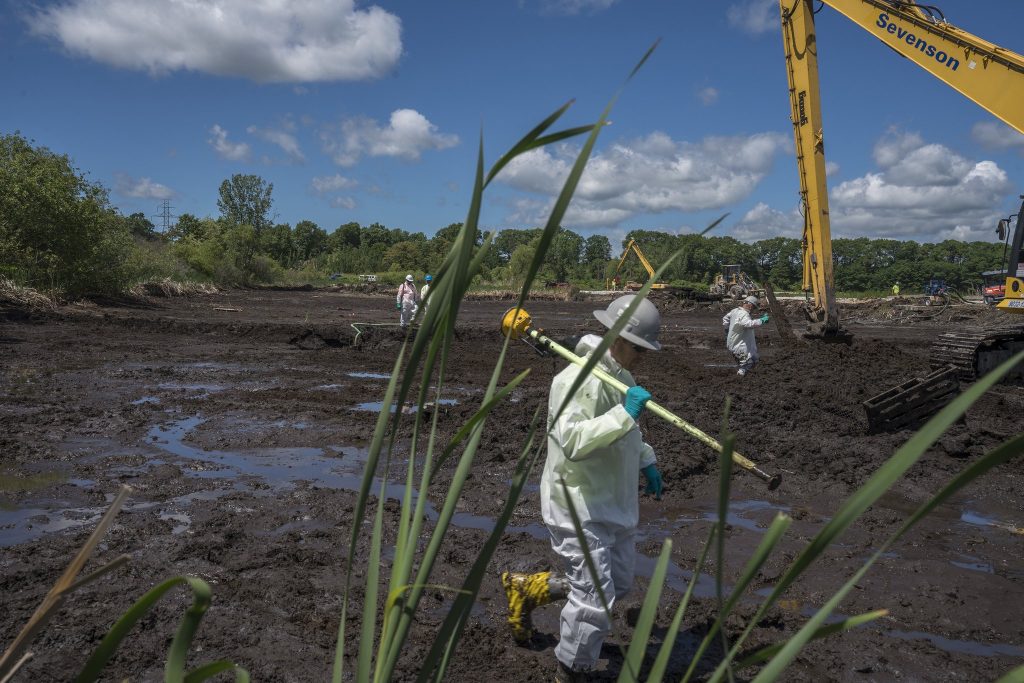
Workers accurately measure with GPS instruments the extent of the contamination before the oil-tainted soil was removed with heavy equipment. The soil was dewatered before being sent to a landfill. When the site was clean, new soil was placed and native vegetation planted. (Photo National Geographic / Peter Essick)
Before the cleanup, Caitie Nigrelli, Illinois-Indiana Sea Grant environmental social scientist, and her intern Carly Norris, interviewed residents to understand people’s perceptions of the remediation. Several findings from this effort helped shape how the public was informed as well as the cleanup process itself.
The needs assessment revealed that some residents were confused about what the cleanup entailed, expecting that nearby industrial storage tanks would be removed. “The contamination was historical and in the sediment—that’s what would be remediated,” explained Nigrelli. “We tailored our outreach information to make sure neighbors understood what the cleanup would accomplish.”
The interviews also revealed that many residents were very concerned about possible odors released from digging up petroleum-soaked sediment. To address this, EPA sought input from another federal agency, the Agency for Toxic Substances and Disease Registry, installed an air monitoring system and established a hotline for residents to report odors. The remediation was also timed to take some advantage of cooler months when people don’t typically have their windows open. Onsite, the dredgers used odor suppressing foam and quickly trucked away the smelliest sediment.
To make sure that nearby residents and businesses had accurate and timely information about the cleanup and potential accompanying odors, the outreach team donned their hardhats and went door to door. “We helped correct some rumors about the site and the cleanup so that expectations were where they should be,” said Nigrelli.
The cleanup also provided an opportunity to engage local students in learning about the impact of pollution in their community. In the Reeths-Puffer School District, IISG’s Ben Wegleitner visited 18 classrooms ranging from kindergarten to ninth grade, altogether talking to 250 students. He brought drone videos of the remediation work so the students could see the project progress.
“We talked about the wetland and how it’s connected to the Muskegon River and Muskegon Lake and then Lake Michigan,” said Wegleitner. “The cleanup of the wetland has impact on both the local scale and in context of the entire Great Lakes.”
Locally, Evans’ organization is already on to the next project to make the most of this work. “We were able to get funding from EPA and NOAA to restore another 53 acres of fish and wildlife habitat adjacent to Zephyr, immediately upstream,” she said. “This will make for a bigger, more meaningful and connected restored area from a fish and wildlife habitat perspective.”
For more information about the Zephyr cleanup (including before and after drone videos) and contaminated sediment in the Great Lakes, visit Great Lakes Mud.
August 22nd, 2018 by iisg_superadmin
The economic impact of the Illinois and Indiana Lake Michigan recreational fishery on the local economy was more than $44 million in 2015, according to Illinois-Indiana Sea Grant (IISG) research. Recreational fishing supported 407 jobs in the two states.
IISG funded two studies to estimate the economic value of the Lake Michigan fishery in Illinois and Indiana. At the Illinois Natural History Survey (INHS), Sergiusz Czesny, Craig A. Miller, and graduate student Elizabeth Golebie looked at how much anglers actually spend and estimated the impact of those dollars.
They questioned anglers about their typical fishing trip expenses and found that shore-based anglers spent an average of $56 and boating anglers spent $255. Annual creel surveys, which are done in person along the shoreline, provided a point of contact so that the researchers could target their questionnaires to anglers who fish in Lake Michigan. In Illinois, INHS is responsible for the creel surveys along the shoreline in Cook and Lake counties. In the Indiana counties of Lake, Porter and LaPorte, the creel surveys are done by the state’s Department of Natural Resources.
The researchers estimated the total economic impact of Lake Michigan non-charter anglers in Illinois waters at $22.4 million, providing 231 jobs. Indiana non-charter anglers contributed $12.7 million to the local economy, supporting 176 jobs in the three counties. Illinois charter fishing anglers were also included in this study and comprised the remaining economic impact that altogether totaled more than $44 million.
“There’s a wide range of economic activity going on with fishing,” said Miller. “These numbers provides more evidence that we need to maintain these fisheries. Several sectors of the economy are dependent on a healthy fishery with healthy fish populations and angler access.”
In both states, the overwhelming majority of fishing—75 percent—was for salmon species, which include coho and chinook salmon, as well as brown, lake and rainbow trout. Only 6 percent was dedicated to yellow perch, and the remainder for other species, such as bass.
Mitchell Zischke and graduate student Xiaovang He at Purdue University, and Benjamin Gramig at the University of Illinois tell more of the story in their economic evaluation research. Using a non-market approach to quantifying the value of the Lake Michigan fishery in the two states to the anglers themselves, they estimated anglers’ willingness to pay for a day-trip spent fishing. They added questions to the 2015 Illinois and Indiana creel surveys to do a travel cost study, estimating the value of fishing based on how far anglers traveled and how much time it took to get to fishing sites.
“In addition to direct expenditures, anglers allocate time and effort to fishing instead of work or other activities, and this is the basis for these estimated values,” said Gramig.
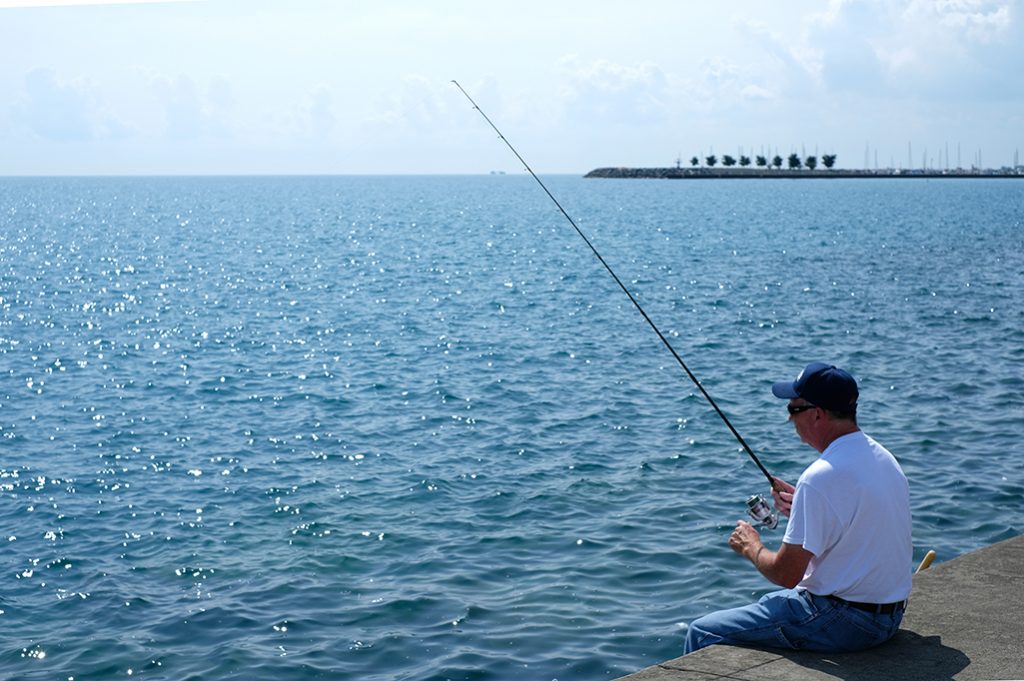
Anglers interviewed during the 2015 creel surveys along Lake Michigan were willing to pay an average of $30 to take a day trip fishing and their average travel distance was 28 miles. Illinois anglers have a slightly higher willingness to pay than those from Indiana and boaters have a higher average, at $40, than shore-based anglers, who are willing to pay $26.
The total estimated non-market economic value of recreational fishing was $3.6–4.0 million, which represents additional value over and above expenditures on food, fishing supplies and other associated items included in Miller and Czesny’s estimates.
“Support for the economy through recreational fisheries is a complex web,” said Zischke. “Having some understanding of these numbers is important. For example, if there’s a potential to open up a fishing site, it’s critical to know that it may add millions of dollars to the economy.”
Zischke and Gramig also looked at 30 years of creel survey data to get a historical perspective on the Lake Michigan fishery and connect trends with environmental or management changes.
The data revealed that while the two states share Lake Michigan waters, they have noteworthy differences in fishing practices. “We noticed a large decline in the fishing effort in Illinois,” said Zischke. Fishing effort back in the mid-1980s added up to over 2 million angler hours per year—since the early 2000s it has stabilized at 500,000 annual angler hours.
Zischke attributes the reduction in Illinois fishing hours to the drop in yellow perch numbers. “The decline in fishing effort follows a similar timeline to declines in catch rates of yellow perch,” he said.
“In Indiana, however, we did not find a similar decline in fishing hours,” said Zischke. “Fishing hours have been stable at 300,000–400,000 over the last 30 years. Typically, the catch rates of yellow perch in Indiana have been historically lower than in Illinois and they have actually been quite stable through time.”
The historical creel survey data also revealed that most Illinois anglers have engaged in shore-based fishing, whereas Indiana anglers have been predominantly on boats. This may be due to the fact that Illinois has a higher population along the lakefront and more access to fishing along its shores.
The research team has made the creel surveys’ 50,000 records collected from 1986 to 2013 available for other researchers, resource managers and anglers to easily access on the Angler Archive website. Plans are in the works to update the website with more recent data.
July 16th, 2018 by iisg_superadmin
Due to an increase in insect-borne diseases in Illinois, Illinois-Indiana Sea Grant (IISG) has been working towards informing natural resource professionals about how they can protect themselves when their jobs take them outdoors. An informational piece from this campaign has won a 2018 APEX Award of Excellence in the category of Best Redesign.
Through workshops and publications, IISG’s aquatic invasive species (AIS) team has been working to bring information about both tick and mosquito-borne disease prevention to a targeted audience. In this effort, a Lake County tick identification card that includes tips for protecting oneself was enhanced and adapted for a Spanish-speaking audience. Pat Charlebois, IISG’s AIS outreach coordinator, oversaw the process, along with Danielle Hilbrich. Graphic designer Joel Davenport created the look of the publication.
Altogether, 255 natural resource professionals attended the workshops, with 35 of those attending a Spanish-language one. If you would like more information about protecting yourself from tick- or mosquito-borne diseases, visit Lake County’s website Fight the Bite.
APEX awards are given each year to recognize outstanding publication work in a variety of fields by Communication Concepts.
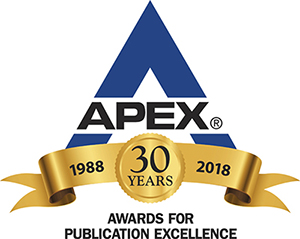
May 2nd, 2018 by iisg_superadmin
University research projects often include an opportunity for a few students to get real-world field or laboratory experience. At Loyola University Chicago’s Micro Eco Lab, biologists Tim Hoellein and John Kelly have often found ways to connect students with their work. But when they set out to implement the lab’s recent Illinois-Indiana Sea Grant project, opportunities for students really took off.
To accomplish this ambitious, comprehensive study to assess microplastic levels in Lake Michigan waterways efficiently and timely, Hoellein and Kelly brought on a post doc to oversee the project. Rachel McNeish looked to students to get much of the work done and the pool of helpers grew to dozens—35 in all, including graduate, undergraduate, and high school students.
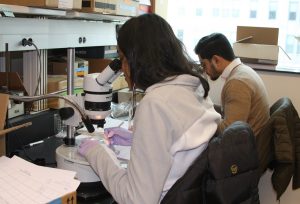
“Students were involved with fieldwork, sampling and processing,” said McNeish. They did all the lab work, including data curating—making sure it was entered correctly. Some students have been in charge of specific aspects of the process, making sure it is happening as it should. They then have an opportunity to take a portion of the dataset, analyze it, and present it on campus or at professional conferences.”
For Masters student Lisa Kim, her time spent working on microplastic research and outreach turned out to be life changing. She started her undergraduate tenure at Loyola as a pre-med student, but changed directions after her experience working on the Sea Grant project. “I really fell in love with lab work—getting samples and processing them, and then data analysis and even presenting the results on campus,” said Kim.
She is now an author on the first journal article from the IISG microplastic study, which thus far has found plastic microfibers in the water, sediment and fish in three main Lake Michigan rivers.
Kim is also working on her own research and is exploring opportunities to engage in outreach and in the policy process. “I really want to communicate information about microplastic pollution with everyone. I feel like I got experience working in the lab and doing research, but now I want to bridge the gap between scientists and the community.”
The students come from diverse backgrounds, including some who are first generation college students, and bring a range of interests and experiences. Many are new to the tasks at hand.
“My first time in the field was quite the challenge, balancing being in the canoe with sediment samples and other heavy equipment, all while trying to collect different types of samples from the water,” said Melissa Achettu, a Loyola junior.
Achettu, who has now been working on the IISG project for 18 months, has been funded by two Loyola fellowships to help with the study and to present findings at an international conference this spring.
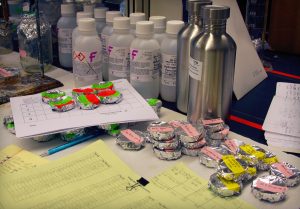
With Loyola’s setting in Chicago, some students are also experiencing nature and camping for the first time. And with such a busy lab, they are developing leadership skills and learning to work together.
“I enjoy working in the lab with so many other students because it’s a great learning experience when people of so many backgrounds come together,” said Achettu. “Everyone has their unique inputs and ideas. We all learn patience, teamwork and communication skills.”
McNeish puts herself in that camp. “Undergraduate students have just been phenomenal the whole time I’ve been doing research and throughout my education,” she explained. “I feel like I can teach them many things, but they can also teach me a lot too. It’s a two-way learning system. And working with a large group, everyone has something to learn.”
As the research wraps up, McNeish herself is moving on to a new opportunity. She will start a tenure-track faculty position at California State University Bakersfield this August where, as a freshwater scientist, she plans to develop her own student-focused research program.
March 28th, 2018 by iisg_superadmin
As you dine on locally-caught fish, you probably aren’t thinking of that old acrylic sweater or fleece jacket that you wear and wash frequently. But it turns out that they may be on your plate. Illinois-Indiana Sea Grant-funded researchers have found microplastic fibers that come from clothing and other sources in the water, in sediment and in fish in three major rivers that flow into Lake Michigan.
Loyola University Chicago biologists John Kelly, Tim Hoellein and Rachel McNeish are assessing levels of microplastic using a range of measures. As part of a larger study, they collected samples from the mouths of the Muskegon, Milwaukee and St. Joseph rivers seasonally over the course of 2016 and into 2017.
“We found that 99 percent of the microplastic is fibers, and microfibers are everywhere,” said McNeish, a post doc who implemented the project. “Much of what we found is acrylic, polyester, and polyethylene, which comes from plastic bags.” These plastics break down to microscopic size in the water due to physical abrasion, sunlight and freezing.
While water sampling is typically done using nets, the Loyola team also sampled water directly. “We started doing these grab samples, we just fill up a liter container and bring it back and filter it, and we found particles smaller than 300 microns, the pore size of the nets,” said Kelly. “The smaller you go, the more numerous the pieces of plastic there are.”
The three rivers in this study have provided insight into the effect of how we use the land on how much microplastic is in the environment, which was a key goal of this project.
The most northern river, the Muskegon, which flows through land dominated by forests had less microplastic than the other two rivers, as one might expect. Moving south to more populated and developed areas, are the St. Joseph River, in a farm-rich watershed, and the Milwaukee River, which sits in a mixed, urban and agricultural region. The researchers found that both agriculture and urban land uses contribute significantly to the abundance of microplastic in these Lake Michigan tributaries.
“Ultimately what we really want to do is predict what aspects of our development or features of the landscape pose bigger problems when it comes to contributing microplastic to the landscape,” said Hoellein. “And we need to understand where microplastic accumulates the most, because if we don’t answer those questions, we’re not really in a good position to come up with a solution or even address the problem.”
The researchers also sampled 74 fish from the shallow waters of these three rivers and 85 percent of them, including bass and other sportfish, contained microplastic in their digestive tract, averaging 13 particles. They found that the amount of microplastic in individual fish was not a reflection of how much plastic was in the water—fish from all three sites had similar numbers of microfiber in their digestive system.
How much microplastic shows up in one fish versus another can better be explained by looking at the food web. The researchers found that fish that eat insects and other invertebrates, which may already contain microplastic, have more fibers than those that eat plants.
“Microplastic is interacting with aquatic wildlife,” said McNeish. “Fish are consuming it—either actively eating it thinking its food, eating insects with microplastic in them or maybe just drinking water with microplastic. Or they may consume it through contact with sediment. In any case, microplastic is entering the food web.”
“And as these three rivers drain into Lake Michigan,” she explained, “the movement of microplastic can happen with the rivers’ currents, but also through the migration of animals.”
February 20th, 2018 by iisg_superadmin
As the new director for Illinois-Indiana Sea Grant (IISG), I’d like to provide some insight into some dramatic changes that happened over the past two years as we switched administrative leads. As a bi-state program jointly managed by the University of Illinois and Purdue University, at any given time, one of these institutions has served as the lead. U of I was the initial lead from 1983 to 1994. Purdue served as the lead in 1994–2001, and again, U of I led the program from 2001 to 2018. Since February 2018, Purdue University is once again the institutional lead for IISG.
To maintain a long-term, equitable partnership we believe these institutional transitions are healthy. However, they do require substantial administrative adjustments and our recent transition has included turnover in multiple administrative positions. Brian Miller, our long-time director, retired in early 2018. In addition, both our assistant director (Lisa Merrifield) and outreach program leader (Laura Kammin) recently left the program. At the same time, several administrative positions (i.e., dean, associate dean, and department head positions) in our reporting line at the two universities have transitioned over the previous year.
As of 2018, I became the new director. Joining the program or taking on a new role were associate director (Yu-Feng Lin), assistant director (Stuart Carlton), outreach program leader (Pat Charlebois), research coordinator (Carolyn Foley), fiscal officer (Deb Hula), communication coordinator (Hope Charters) and administrative and layout assistant (Ethan Chitty).
We have spent a great deal of time this past year on hiring, team building, partner development, and establishing new work flows and fiscal tracking, but the core of our program’s activities remain consistent and strong. Luckily, several new positions were filled by people with Sea Grant experience who were familiar with the program. For example, Carolyn Foley moved from the assistant research coordinator to research coordinator position, and our research program has continued to support applied research, relevant to the management of Lake Michigan and the environmental and economic health of our region. Importantly, almost all of our more than 15 outreach and education specialists remained in their positions during the transition period. The programs they have developed continue to positively affect communities in southern Lake Michigan and throughout the Great Lakes region.
As we continue the process of transitioning our program, we are excited by the opportunity to build on this past work to continue to engage with students, researchers, and other partners to bring about sustainable and vibrant environments and communities around southern Lake Michigan.
Tomas Höök
Director, Illinois-Indiana Sea Grant
Illinois-Indiana Sea Grant is a part of University of Illinois Extension and Purdue Extension.





